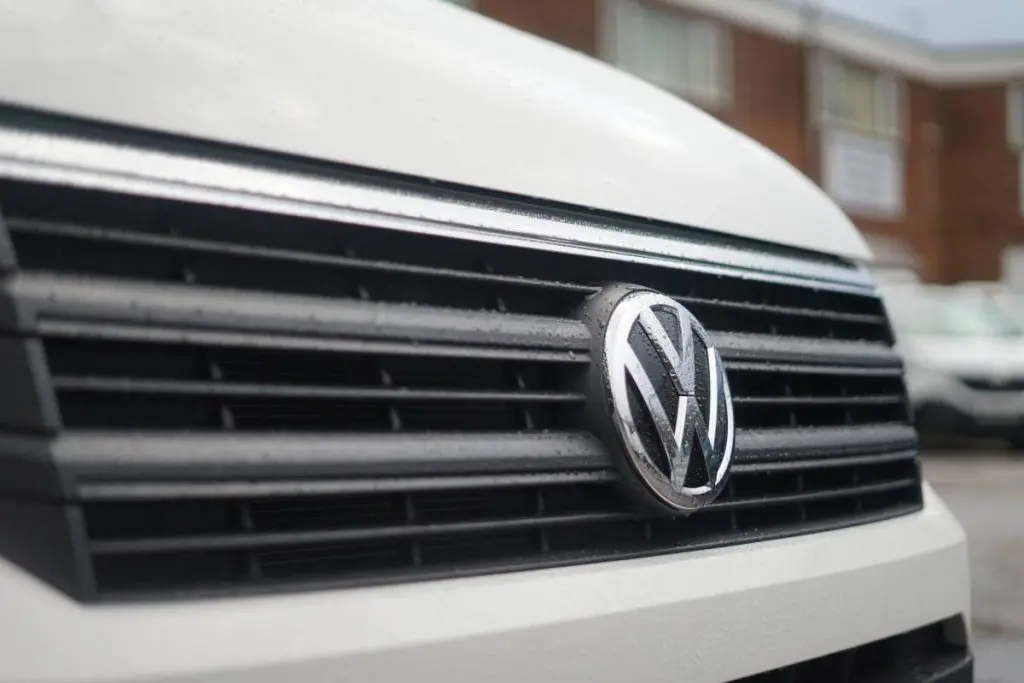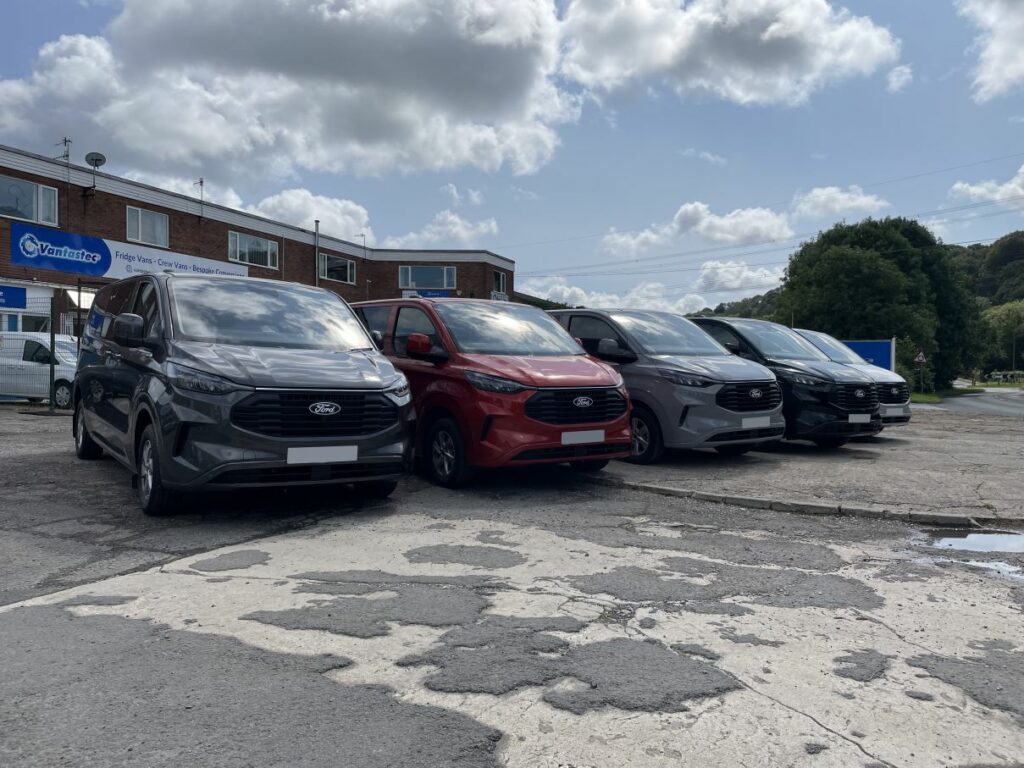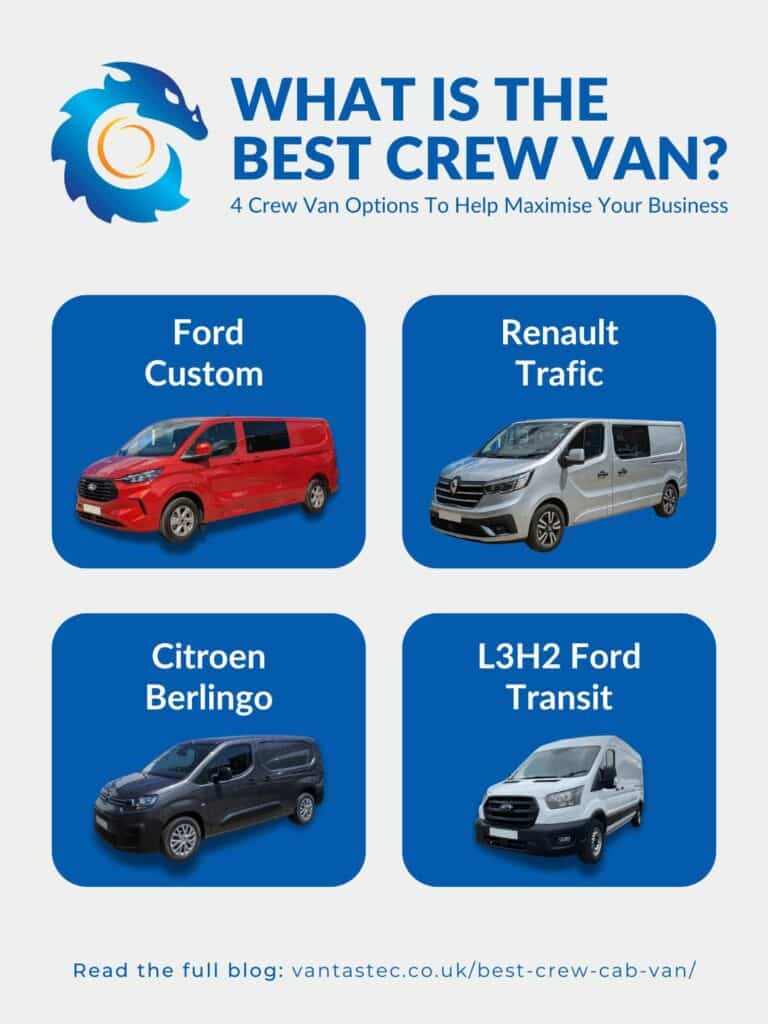What Is The Best Crew Cab Van To Buy In 2025?
What’s the best crew cab van to buy in 2025? We compare models from leading manufacturers to help you choose the right one for you.
So, you’ve decided you need a new crew van for your business, but you have no idea where to start. Choosing the best crew cab van for you can be tough, especially when you have no idea what you are looking for.
It’s important to choose a van that best suits your needs. Different drivers and businesses use their vehicles in different ways. The first thing you should do when searching for a crew van is to make sure you’re looking for one that best caters to your exact requirements.
That’s why, in this post, we’ll be breaking down some of the leading crew cab vans on the market and seeing how they perform in these key disciplines: load space, payload, warranties and fuel efficiency – all of which are important factors to consider when choosing a new commercial vehicle.
In The Market For A Crew Cab? Click Here To Browse Our Full Range Of Crew Vans For Sale
Here are our four contestants:
-
Ford Transit Custom L2H1
-
Citroen Berlingo XL
-
Ford Transit L3H2
-
Renault Trafic LWB
Specifications for the Renault Trafic and Ford Transit Custom will be based on the latest L2H1 models. The Ford Custom also comes in an L1H1 variant, but the Trafic doesn’t anymore, so it’s only fair to compare them in as similar a size as we can.
Meanwhile, the Berlingo only comes in an XL size option, so that’s what we’ll be using.
For the Ford Transit, we’ll be using the L3H2 variant to represent a larger-sized option, as it’s the most popular, in our experience.
Without further ado, here are five of the best crew van models to buy in 2025.
What Is A Crew Cab Van?
Let’s start with the basics. A crew cab van – also commonly known as a double cab van, double cab in van (DCIV), or simply a crew van – is a van that features two rows of seats for the driver and passengers.
Crew vans differ from standard panel vans in many ways, the main one being a reduced load space in exchange for added seating. Both typically feature a fixed bulkhead separating the cab from the rear load space. The number of seats in a crew van can vary, but most feature either five or six seats.
Some models come with a driver’s seat, a single passenger seat and three rear seats, while others usually come with two rows of three seats, allowing for one driver and up to five passengers at any one time. Whether you choose between a panel van or a crew van depends on how much loadspace you need and how many passengers you’d like to fit.
If you need a lot of load space for tools, machinery or other equipment and only need to transport up to three passengers, then a panel van will do just fine. However, if load space isn’t an issue, and you’d prefer the added passenger space, then a crew van might be the way forward.
It’s worth noting that crew vans also tend to be more expensive than standard panel vans.
Load Space
First up: load space.
Having a van with a load area big enough to transport all necessary tools, equipment, or produce is vital to most van drivers.
By choosing a crew van over a panel van, you’re sacrificing a lot of load space. However, you might find that being able to transport all of your crew is more important than having a larger load area. Still, having more load space is always a bonus.
Here is how our contestants compare in terms of their load area:
Ford Transit Custom
Max Length: 2,004 mm
Max Width: 1,777 mm
Max Load Volume: 4.3 cubic metres
Citroen Berlingo
Seats up:
Max Length – 1,450 mm
Max Load Volume – 1.8 cubic metres
Seats down:
Max Length – 2000 mm
Max Load Volume – 3.9 cubic metres
Ford Transit
Max Length: 2,488 mm
Max Width: 1784 mm
Max Load Volume: 7.6 cubic metres
Renault Trafic
Max Length: 2,423 mm
Max Width: 1775 mm
Max Load Volume: 4.3 cubic metres
Load Space Summary
It’s no surprise that the Ford Transit wins this category, being the only large-sized van on our list.
If you need as much load space as possible, the Ford Transit is the best crew cab van option for you. They’re big, powerful and make for the perfect utility vehicle for environmental engineering services and other tough jobs.
With our medium-sized candidates, the Custom and Trafic both come in at 4.3 cubic metres. So not much separates them.
The Berlingo also deserves a special mention.
With fold-away seating to allow up to 3.9 cubic metres of load space, its flexibility makes it a very strong choice, especially if you can get away with a smaller-sized vehicle. If you like the design of Citroen’s Berlingo but need something slightly bigger, the Citroen Dispatch could be worth looking into.
Payload
Next up: payload. Payload is the maximum weight you can legally carry in your vehicle. It’s calculated by subtracting the vehicle’s kerb weight from its gross vehicle weight (GVW). For example, if a vehicle has a gross vehicle weight of 2,500 kg and a kerb weight of 1,500 kg, the maximum payload would be 1,000 kg.
It can be an important factor if you plan on transporting heavy goods or tools. Alternatively, if you plan to use your crew van on family getaways, being able to carry a whole range of camping equipment, bikes, etc., can also be handy.
Here is each vehicle’s average payload:
Ford Transit Custom: 778 – 1,295 kg (1,036.5 kg average)
Citroen Berlingo: 840 kg
Ford Transit: 1310 – 1,415 kg
Renault Trafic: 978 kg
Payload Summary
Again, it’s unsurprising to see the Ford Transit come out on top by a comfortable margin. With a payload ranging between 1,310 kg and 1,415 kg, you’ll be able to transport well over a tonne of goods at once – but that’s to be expected with a vehicle of that size.

Warranties
One of the main advantages of buying new instead of used is that you benefit from the full manufacturer’s warranty.
Used vans that are only a few years old may still have some warranty time left. But that will depend on how old the vehicle is, as well as its mileage. Warranties are important for covering any manufacturing defects free of charge. Such defects include the replacement of faulty parts, damage caused by manufacturing faults and any labour costs for repairs.
However, manufacturers’ warranties only apply to the base vehicle. Any special fittings, conversions or additional bodywork is not covered under warranty. Here’s how each manufacturer’s warranty matches up:
Ford: 3 years or up to 100,000 miles
Citroen: 3 years or up to 100,000 miles
Renault: 3 years or up to 100,000 miles
Warranties Summary
This category is a tie.
If you’re interested in the Renault Trafic, it’s also worth noting that Nissan’s Primastar comes with a five-year warranty up to 100,000 miles. The Primastar is built on the same platform as the Trafic, even in the same factory – the only differences are a different badge and a better warranty.
All vehicles we’re comparing come with what we believe is a sufficient warranty plan. You’ll be saving yourself a lot of money within that three-year period than if you had to pay for all the maintenance yourself. That’s why we advise van buyers to seek new vehicles instead of used ones if possible.
Fuel Efficiency
Last, but by no means least, is fuel efficiency.
Getting your money’s worth when buying a van is important. So, getting one that’s efficient in fuel consumption is a must. Fuel efficiency and miles-per-gallon (mpg) figures are never guaranteed.
There are a number of factors, such as driving style, gross vehicle weight and maintenance, that can affect a van’s fuel economy. Nevertheless, knowing the fuel efficiency of different options on the market is still useful, even if the numbers aren’t 100% consistent.
Here’s how our contestants compare:
Ford Transit Custom: 39.2 mpg
Citroen Berlingo: 50.2 mpg
Ford Transit: 40.9 mpg
Renault Trafic: 40.3 mpg
Fuel Efficiency Summary
NOTE: These figures are for the diesel variants only. All four of our options also come in all-electric versions, with some, such as the Custom, also having hybrid options.
But diesel is still the most used fuel type by UK van drivers. So it makes sense to use diesel vans for our fuel economy comparison.
At over 50 mpg, the Citroen Berlingo tops the charts. Fitted with a smaller, more frugal 1.5-litre engine and a much lighter GVW than the others, this was very much to be expected.
Despite being the largest van in our list, the Transit is the second most fuel-efficient, according to figures from Ford. Which is very impressive.
Between the two medium vans, the Transit Custom wins… just. But the real-life difference will be pretty negligible.
If fuel economy is the single most important factor in your van-buying journey, we’ve also written a guide comparing the most economical vans in each size category. We recommend checking that out.
What Is The Best Double Cab Van?
Truth be told, there’s no such thing as a ‘bad’ crew van these days – especially if you’re shopping for new.
What makes a van the best crew van for you, however, depends on your requirements. Need extra load space? Choose the Ford Transit. Want a smaller vehicle to reduce cost because you don’t need as much load space? The Citroen Berlingo will do the job perfectly.
If we had to choose our favourite all-rounder, the Ford Custom would be our pick for the best double cab van you can buy right now.
Hopefully, this guide has made your decision a little bit easier. If you haven’t yet decided what the best crew cab van for you is, you can compare our range of models by clicking here. We’re happy to answer any further questions in the comments below, or you can email any further questions to sales@vantastec.co.uk.
Related Posts
- 5 Electric Vehicle Benefits Van Users Should Know About
- Finance Lease vs Contract Hire: Which Is Right For You?
- Finance Lease Vs Hire Purchase
Warranties
One of the main advantages of buying new instead of used is that you benefit from the full manufacturer’s warranty.
Used vans that are only a few years old may still have some warranty time left. But that will depend on how old the vehicle is, as well as its mileage. Warranties are important for covering any manufacturing defects free of charge. Such defects include the replacement of faulty parts, damage caused by manufacturing faults and any labour costs for repairs.
However, manufacturers’ warranties only apply to the base vehicle. Any special fittings, conversions or additional bodywork is not covered under warranty. Here’s how each manufacturer’s warranty matches up:
Ford: 3 years or up to 100,000 miles
Citroen: 3 years or up to 100,000 miles
Renault: 3 years or up to 100,000 miles
Warranties Summary
This category is a tie.
If you’re interested in the Renault Trafic, it’s also worth noting that Nissan’s Primastar comes with a five-year warranty up to 100,000 miles. The Primastar is built on the same platform as the Trafic, even in the same factory – the only differences are a different badge and a better warranty.
All vehicles we’re comparing come with what we believe is a sufficient warranty plan. You’ll be saving yourself a lot of money within that three-year period than if you had to pay for all the maintenance yourself. That’s why we advise van buyers to seek new vehicles instead of used ones if possible.
Fuel Efficiency
Last, but by no means least, is fuel efficiency.
Getting your money’s worth when buying a van is important. So, getting one that’s efficient in fuel consumption is a must. Fuel efficiency and miles-per-gallon (mpg) figures are never guaranteed.
There are a number of factors, such as driving style, gross vehicle weight and maintenance, that can affect a van’s fuel economy. Nevertheless, knowing the fuel efficiency of different options on the market is still useful, even if the numbers aren’t 100% consistent.
Here’s how our contestants compare:
Ford Transit Custom: 39.2 mpg
Citroen Berlingo: 50.2 mpg
Ford Transit: 40.9 mpg
Renault Trafic: 40.3 mpg
Fuel Efficiency Summary
NOTE: These figures are for the diesel variants only. All four of our options also come in all-electric versions, with some, such as the Custom, also having hybrid options.
But diesel is still the most used fuel type by UK van drivers. So it makes sense to use diesel vans for our fuel economy comparison.
At over 50 mpg, the Citroen Berlingo tops the charts. Fitted with a smaller, more frugal 1.5-litre engine and a much lighter GVW than the others, this was very much to be expected.
Despite being the largest van in our list, the Transit is the second most fuel-efficient, according to figures from Ford. Which is very impressive.
Between the two medium vans, the Transit Custom wins… just. But the real-life difference will be pretty negligible.
If fuel economy is the single most important factor in your van-buying journey, we’ve also written a guide comparing the most economical vans in each size category. We recommend checking that out.
What Is The Best Double Cab Van?
Truth be told, there’s no such thing as a ‘bad’ crew van these days – especially if you’re shopping for new.
What makes a van the best crew van for you, however, depends on your requirements. Need extra load space? Choose the Ford Transit. Want a smaller vehicle to reduce cost because you don’t need as much load space? The Citroen Berlingo will do the job perfectly.
If we had to choose our favourite all-rounder, the Ford Custom would be our pick for the best double cab van you can buy right now.
Hopefully, this guide has made your decision a little bit easier. If you haven’t yet decided what the best crew cab van for you is, you can compare our range of models by clicking here. We’re happy to answer any further questions in the comments below, or you can email any further questions to sales@vantastec.co.uk.
Related Posts





